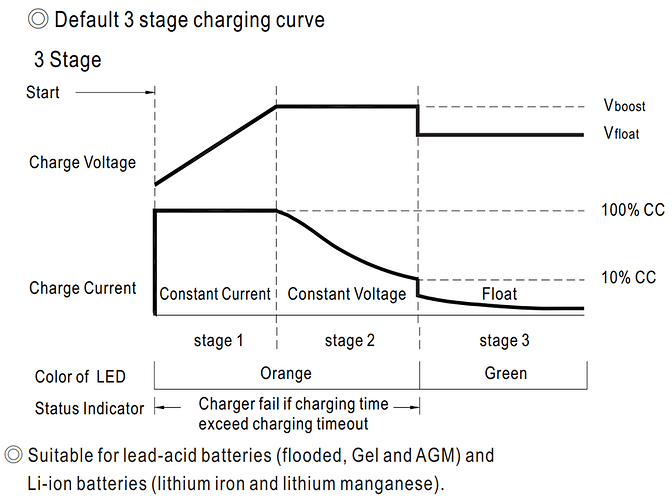Not recommended as a stand-alone solution.
Instead, use a purpose-built charger that is matched to the battery.
Batteries are surprisingly sensitive to charging. Without proper care and feeding, they will not be optimally charged, and they may have a short life. In fact, an inappropriate or misconfigured charger will boil the battery destroying your expensive asset in less than a month.
Case study
As a case study, let’s explore two closely related products from MEAN WELL. These devices have a similar size and maximum power rating. They may both be adjusted for a nominal 12 VDC. The part numbers are similar:
-
The RPB-1600-12 intelligent battery charger is shown in Figure 1.
-
The RCP-1600-12 looks almost identical but functions as a fixed voltage AC to DC converter.
Figure 1: Image of the Mean Well RPB-1600-12 battery charger.
Review of key specification
A quick review of the specifications allows us to differentiate between the charger and the converter.
The MEAN WELL AC to DC converter has a fixed output voltage that is adjustable between 11.5 and 15 VDC.
The MEAN WELL charger includes many features designed specifically for battery charging. Here are a few of those intelligent features:
-
Designed for Batteries – Supports lead-acid (Gel, Flooded, AGM) and Li-ion (Lithium Iron, Lithium Manganese) batteries.
-
Built-in Charging Management – Default 3-stage charging curves and programmable profiles ensure optimal battery health.
-
Safety & Protection Features – Includes protections against:
- Battery under-voltage
- Battery disconnection
- Short circuit
- Over-voltage
- Over-temperature
-
Intelligent Control & Communication with built-in I²C interface and PMBus protocol (with optional CANBus).
What is a three-stage charging profile?
Optimal battery charging requires more than just applying the nominal battery voltage. The three-stage charge profile shown in Figure 2 provides a good starting point to help us understand the difference between charger and converter.
What are the steps in the three-stage battery charging curve?
The three steps are designed to limit the stress applied to the battery and the battery charger.
-
Bulk Charge (constant current mode): The charger operates in a constant current mode as the battery quickly absorbs a charge. The bulk charge mode ends when the battery reaches the desired charging voltage.
-
Absorption (constant voltage): The charger maintains a constant voltage mode the battery current gradually decreases. To ensure a complete charge, the absorption voltage may be higher than the battery’s nominal voltage. Most chargers have the option to end the absorption mode when the current drops below a programmed threshold. It may also be time based.
-
Maintenance (float): For select battery chemistries, the charger enters a float mode where a constant voltage is applied (24 x 7). The float mode ends when the charger detects a battery discharge below a certain voltage. This will start the charging process all over again.
Tech Tip: The float charge is not a universal mode. While it is standard practice for lead acid batteries, it will destroy select types of lithium-ion batteries. As noted, the MEAN WELL charger is programmable. We can expect an option to turn the charger off when the absorption mode is complete. It may then be programmed to periodically restart a charge cycle to mitigate the battery’s natural self-discharge.
Tech Tip: Normally we call upon the battery when primary power is lost. However, if available, the charger will continue to supply up to its rated current. We must consider this fact when testing the battery, as we could overoptimistically assess the battery’s condition.
Figure 2: Default 3-stage charging for MEAN WELL battery charger.
Additional reading
For additional information about batteries please refer to Battery University. There you will discover an in-depth exploration of battery types, characteristic, and charging requirements.
Always carefully review the datasheet for your battery and follow all manufacturer recommendations. There may also be white papers available from the manufacturer.
Tech Tip: Not all battery applications are designed for long life. High-performance applications may sacrifice battery life for weight. The RC drone or other racing applications prioritize performance over life. It’s like the internal combustion engine for a top fuel drag racer. They are designed for a few spectacular runs.
Parting thoughts
The AC to DC converter and the battery charger are closely related. The primary difference is the intelligence in the battery charger designed to match the charging cycle to the battery. An example is the default three-stage charge cycle.
For select applications it may be desirable to place the AC to DC converter under computer control. This would force the converter to act as a battery charger. However, for the vast majority of applications we are better off using a purpose-built battery charger.
Be sure to read the Battery University material as we live in a fascinating technological world.
Sincerely,
Aaron
Related information
Please follow these links to related and useful information:
About this author
Aaron Dahlen, LCDR USCG (Ret.), serves as an application engineer at DigiKey. He has a unique electronics and automation foundation built over a 27-year military career as a technician and engineer which was further enhanced by 12 years of teaching (interwoven). With an MSEE degree from Minnesota State University, Mankato, Dahlen has taught in an ABET-accredited EE program, served as the program coordinator for an EET program, and taught component-level repair to military electronics technicians. Dahlen has returned to his Northern Minnesota home and thoroughly enjoys researching and writing articles such as this.


